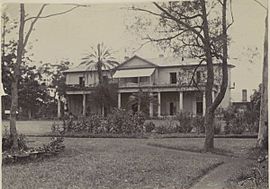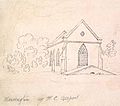Newington House facts for kids
Quick facts for kids Newington House |
|
|---|---|

Newington House, c. 1894
|
|
| General information | |
| Type | House |
| Architectural style | Regency villa |
| Location | Silverwater, New South Wales |
| Country | Australia |
| Coordinates | 33°49′44″S 151°03′25″E / 33.829°S 151.057°E |
| Construction started | 1829 |
| Completed | 1832 |
| Owner |
|
| Technical details | |
| Structural system | Stone and cement rendered brick |
| Design and construction | |
| Architect |
|
| Official name | Silverwater Correctional Complex - Newington House & Grounds |
| Type | Built |
| Designated | n.d. |
| Part of | Silverwater Correctional Centre |
| Reference no. | Heritage Act - s.170 NSW State agency heritage register |
| Group/collection | Law Enforcement |
| Category | Prison |
| Official name | Newington, Holker St, Silverwater, NSW, Australia |
| Type | Historic |
| Criteria | Defunct register |
| Designated | 21 March 1978 |
| Part of | Silverwater Correctional Centre |
| Reference no. | 2958 |
| Official name | Newington Chapel, Holker St, Silverwater, NSW, Australia |
| Type | Historic |
| Criteria | Defunct register |
| Designated | 21 March 1978 |
| Part of | Silverwater Correctional Centre |
| Reference no. | 2959 |
Newington House is a very old and important house in Silverwater, New South Wales, Australia. It is about 20 kilometers west of the main city area of Sydney. You can find it on the southern side of the Parramatta River. Today, it is part of the Silverwater Correctional Centre. Newington House is seen as one of the three most important old houses in the County of Cumberland. The other two are Elizabeth Bay House and Camden Park.
Newington House is a great example of a country villa from early colonial times. It shows how important people lived back then. The house was built for John Blaxland, a well-known businessman. His family was one of the oldest in the colony. His brother, Gregory Blaxland, also helped with activities linked to the area. Over time, Newington House has been used for many different things. It was once a college, an asylum, a hospital, and now it is a prison administration building. This shows how society has changed over the years.
Contents
The Newington Estate: A Look at Its History
The land where Newington House stands was originally Aboriginal land. It belonged to the Wann-gal people. Their land covered the southern side of the Parramatta River.
Early Land Grants and John Blaxland's Vision
In the early days of European settlement, large pieces of land were given to settlers. In 1807, John Blaxland bought about 520 hectares of land. He named his new estate "Newington." This name came from his family's home in Kent, England. Blaxland was a smart businessman. He set up salt pans along the Parramatta River. By 1827, he was making 8 tons of salt every week for Sydney. He also built a tweed mill, a lime kiln, and a flour mill.
Changes in Ownership and New Uses
In 1843, Blaxland borrowed money using the property as security. After he passed away in 1851, the property was sold to John Dobie. But the Blaxland family bought it back in 1854. Later, in 1860, the property was leased to the Methodist Church. They started Newington College on the estate. The college stayed there until 1880.
Subdivision and Development Plans
In 1877, John Wetherill bought the property. The next year, he planned to divide the huge 520-hectare estate into many smaller blocks. He hoped people would buy these blocks because of new job opportunities nearby. These jobs were at the State Abattoir and Brickworks. However, this plan did not work very well. Only a few blocks were sold. Still, the way the western part of Newington was planned can still be seen in the streets today.
Newington as a Hospital and Prison Site
In 1879, the government looked at Newington estate for a boys' reform school. They decided it would be good for an asylum for older women instead. In 1897, the government bought about 19 hectares of land, which included Newington House. A new hospital for older women was built there in 1886. It could hold 300 patients. Over the years, more buildings were added to Newington Hospital. In 1960, there was a plan to close the hospital and sell the land to factories. But many people did not like this idea. In 1968, the government decided to close the hospital. The property was then given to the NSW Department of Prisons.
Newington House: A Historic Building
Newington House is a two-story Regency style house. It was built between 1829 and 1832. It looks like an English mansion with neat English gardens. In its best days, the Blaxland Estate was famous for its beautiful gardens and fruit trees. Today, the house is in the middle of the Silverwater Corrective Centre.
Architectural Style and Features
The front of the house is balanced, with a central part that sticks out and has a triangular top. The main entrance door has a fancy fanlight above it. We are not sure who designed the house. Some say it was John Verge, others say Henry Cooper. No original drawings have been found. The house was drawn by architect William Hardy Wilson in the 1920s. His drawings showed colonial buildings in a romantic way.
Current Use and Unique Details
Today, Newington House is used as an office building for the Silverwater Corrective Centre. The house is special because of its unique style. From the outside, it looks like a typical Regency building. The verandah was added later and might look a bit odd, but it makes a nice entrance. Inside, the room layout is important. The wooden details are strong but simple. They show how people tried to build in the style of famous architects like Verge. This also gives us an idea of the building skills of that time.
The Chapel: St Augustine's
The Blaxland family had their own chapel, called St Augustine's. It was built in 1838. A marble sign above the main door tells us this. It is a single-story brick building with a smooth finish. It has strong supports at the corners and a rectangular shape.
Design and Religious Importance
The chapel's design mixes Gothic Revival and Georgian styles. It has flat columns, a decorative band, and a triangular gable. The pointed windows have simple patterns, colored glass, and clover-shaped vents. These features are typical of the Gothic Revival style. St Augustine's Chapel shows how strong the Blaxland family's religious beliefs were.
The Garden: A Living History
Some parts of the old house garden and estate landscaping are still there today. You can still see the shape of the old circular driveway north of the house. There are also old trees and a path of rainforest trees and palms leading north towards the river.
Remaining Garden Features
Closer details like a stone stand and a decorative urn are still east of the house. They are on the edge of the old driveway. Trees along the old driveway include Canary Island date palms and cotton palms. These palms have tall, smooth trunks. A path of trees towards the river has Bunya Bunya pines, hoop pines, and Moreton Bay figs. Some of these trees might have been planted later.
Important Tree Species
Many of the walkway trees were planted between the 1860s and 1900. This was a time when these types of trees were very popular. People like Charles Moore and Joseph Maiden, who were directors of the Royal Botanic Gardens, Sydney, helped promote these trees. They gave these trees to many public places, including hospitals. Cotton and Canary Island date palms were also popular then. Near Holker Street, you can see large Hill's figs and Moreton Bay figs. These trees were moved from other parts of the estate. They are at least from the 1880s, maybe even older. Other important trees on the site include the very rare Schotia afra and turpentine trees. The turpentine trees are likely native to the area.
Newington College: A School's Beginning
In 1862, a plan was made to start a college in Sydney. It was meant to be a Methodist school but open to all students. On July 16, 1863, the Wesleyan Collegiate Institute opened. It had 16 boys and a few students studying religion.
Newington House as the First Campus
Since there were no other suitable buildings in Sydney, Newington House was rented. The school soon became known as Newington College. It did very well during its time by the Parramatta River. In 1869, it was the first Australian school to play rugby football. Soon after, it was also the first school in Australia to hold an athletics carnival. The Newington College Cadet Unit is the oldest cadet group in the Australian Army Cadets.
Moving to a New Location
More and more students joined, so the college needed a bigger place closer to the city. A man named John Jones left some land in Stanmore to the college. So, in 1880, the college moved to this new, more fashionable area. The college council decided to keep the name "Newington College." The school has been in Stanmore ever since.
Newington, The Suburb
Newington, New South Wales is a modern suburb. It was built partly on the land that used to be the Newington House estate. It is on the western side of Homebush Bay, along the Parramatta River. It is about 1 kilometer north-west of Sydney Olympic Park.
Olympic Village and Residential Area
Newington is best known as the place where the Athletes Village was built for the Sydney 2000 Olympics and 2000 Summer Paralympics. After the Games, the Athlete's Village was turned into apartments for people to live in. Other apartments and two-story houses have also been built there since then.
Newington Armory was a place where the Royal Australian Navy (RAN) stored ammunition. It was built on the old Newington House estate.
In 1897, the Royal Marines built a powder magazine and camp there. It was used to store ammunition for British navy ships. In 1910, Australia passed a law to create its own navy. The Commonwealth then took over the ammunition depot. They made it bigger and it became known as the Royal Australian Naval Armament Depot (RANAD). The Australian Navy started to leave the site in 1996. The land was then given to the Government of New South Wales. It was developed into the Sydney 2000 Olympics Athlete's Village and the suburb of Newington.
Gallery




